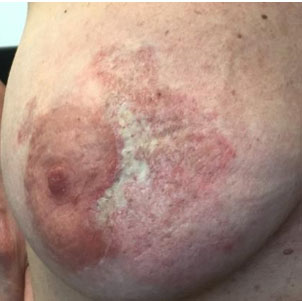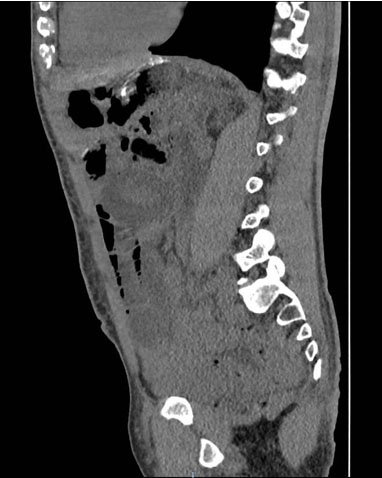 |
Case Report
Exuberant condylomata lata in the differential diagnosis of perianal disease
1 Resident, General Surgery Department, Hospital do Espírito Santo de Évora, Évora, Portugal
2 Junior Surgeon, General Surgery Department, Hospital do Espírito Santo de Évora, Évora, Portugal
3 Infectiologist, Infectious Diseases Department, Centro Hospitalar do Baixo Douro e Vouga, Aveiro, Portugal
4 Senior Surgeon, General Surgery Department, Hospital do Espírito Santo de Évora, Évora, Portugal
5 Chief of Department, General Surgery Department, Hospital do Espírito Santo de Évora, Évora, Portugal
Address correspondence to:
Maria Cristina Botelho Hasse Velez
R. Almada Negreiros, 28, 7005-288,
Évora
Message to Corresponding Author
Article ID: 100119Z06MV2023
Access full text article on other devices

Access PDF of article on other devices

How to cite this article
Velez MCBH, Lima R, Bolota J, Machado A, Velez J, Silva A, Félix R, Carvalho M. Exuberant condylomata lata in the differential diagnosis of perianal disease. Case Rep Int 2023;12(2):6–9.ABSTRACT
Introduction: Perianal pathology includes a variety of lesions with a vast array of etiologies and therefore the treatment and prognosis are diverse. The negative impact in the quality of life is generally meaningful. Depending on the context where the patient is observed, some causes are not always remembered when the differential diagnosis is discussed.
Case Report: We present the case of a 70-year-old male presenting to the emergency department with painful exuberant perianal lesions, referred to General Surgery observation, whose diagnostic pathway was time consuming. The patient was subjected to excisional biopsies and an abdominal computed tomography before the correct clinical diagnosis was suspected and serologic studies ordered. A clinical diagnosis of condylomata lata was eventually reached when a specialist in infectious diseases was consulted which allowed for correct investigation and treatment.
Conclusion: This case illustrates the importance of considering infectious diseases as causing perianal manifestations and of different specialties working together. This can diminish the delay of treatment, giving back the patients’ quality of life and avoiding time and money consuming exams and treatments.
Keywords: Condylomata lata, Malignancy mimicking, Perianal disease, Syphilis
INTRODUCTION
Perianal pathology includes a variety of manifestations of multiple diseases, sometimes very similar and difficult to distinguish from each other [1]. Generally having a profound negative impact in the patients’ quality of life, their prognosis and therapeutic options are diverse. Ranging from infectious diseases to malignancy, the medical specialties to which they present can vary and, depending on who the patient is referred to, some causes are not always remembered when the differential diagnosis is discussed.
Syphilis is a sexually transmitted disease caused by Treponema pallidum and presents in four stages that can overlap, being them primary, secondary, tertiary, and latent syphilis [2]. Condylomata lata are an infrequent manifestation of secondary syphilis [3],[4].
We present a Condylomata lata case report in which, after a non-linear diagnostic pathway, initially focusing mainly on excluding malignancy, the instituted therapeutics, after achieving the correct diagnosis, devolved the patients’ quality of life quite quickly.
The purpose of this case report is to discuss the differential diagnosis of perianal pathology, recalling the non-surgical etiologies that are less frequently managed in General Surgery departments and, therefore, can pose a challenge to the surgeon [4]. In hospitals that have no Infectious Diseases department, like ours, this can have a significant impact in patient management and outcomes.
CASE REPORT
We present the case of a 70-year-old male patient who came to the emergency department (ED) of our hospital complaining of perianal discomfort and pain with several weeks of duration, that aggravated during straining and defecation. The case was forwarded to the surgical team. The patient denied any relevant previous history or current diseases as well as any medication. When asked, he denied unprotected sexual intercourse. He was underweight and poor hygiene was noticed. On physical examination it was assumed that an anal fissure was causing the symptoms and the patient was medicated accordingly, with a topical cream (containing zinc oxide, titanium dioxide, and tetracaine hydrochloride), a stool softener (lactulose), and oral analgesia (paracetamol). The patient returned to the ED a month later with the same complaints. On the physical examination an exuberant papillomatous lesion associated with perianal moisture was observed and an incisional biopsy was performed, thinking of a neoplasm of the anal canal or rectum. A follow-up appointment in the outpatient clinic was scheduled.
The biopsy revealed an inflammatory infiltrate, was negative for human papillomavirus infection, and suggested no diagnosis. In the outpatient clinic appointment, blood tests for human immunodeficiency virus (HIV), B hepatitis virus (HBV), and C hepatitis virus (HCV), and a contrast-enhanced computed tomography (CT) of the abdomen and pelvis were ordered. The serologies were negative for HIV, HCV, and HBV, and the CT showed only an external mass with no internal or intrarectal growth.
The patient again returned to the ED after a month, maintaining the same complaints, and on physical examination a growth of the lesion was observed (Figure 1), as well as new lesions in the penis and bilateral inguinal adenopathy. The patient was observed by Dermatology and the diagnosis of an infectious disease was suggested and a new biopsy was performed. As there is no Infectious Disease Department in our hospital, the case was discussed with an infectious disease specialist from another hospital and a photograph of the lesions was sent. The hypothesis of condylomata lata was posed as the most likely diagnosis and Rapid Plasma Reagin (RPR) and T. pallidum hemagglutination assay (TPHA) blood tests were ordered. Because of the high clinical suspicion, immediate empiric therapeutic with intramuscular penicillin G benzathine, 2.4 million units, was administered. The patient was advised to warn any sexual partners to be tested. Serologies confirmed infection with T. pallidum, with a RPR of 128 Kahn Units and a TPHA with a titer of 1/10240. The response to the instituted therapy was very satisfactory and the patient presented in the outpatient clinic after three weeks, showing a significative reduction in the size of the perianal lesions (Figure 2), disappearance of the penile lesions and mentioning a marked improvement in his quality of life. By this time the second biopsy result was verified and was again not conclusive but posed the hypothesis of a spindle cell carcinoma, diagnosis that was discarded because of the regression of the lesions after administration of penicillin G benzathine.
DISCUSSION
Perianal pathology is vast and englobes a large variation of signs and symptoms that have multiple etiologies and very different prognosis [1]. Most of the patients referred to the General Surgery outpatient clinic for perianal complaints present with hemorrhoidal disease, perianal fistulizing disease, and anorectal or perianal skin neoplasms. Despite these being the most common diagnosis, the differential diagnosis should also consider infectious diseases like condylomata lata in the context of secondary syphilis (T. pallidum), condylomata acuminata (HPV), tuberculosis (Mycobacterium tuberculosis), lymphogranuloma venereum (Chlamydia trachomatis), and chancroid (Haemophilus ducreyi) [3]. It is important to note that the differential diagnose of perianal warty lesions is commonly difficult to make based solely on the macroscopy. Many of the perianal presentations of infectious diseases are similar and share overlapping features.
Each medical specialty is used to a different specter of diseases and a less frequent clinical diagnosis can be missed [3]. As the surgeon is mainly familiarized with the previously mentioned diagnosis, the diagnostic pathway is not always conducted in a hastily fashion concerning the other pathologies. In this case, the initial investigation concerning non-surgical diseases was limited to HIV, HBV, HCV, and HPV exclusion, with the articulation with an infectious disease specialist being crucial to arrive to a clinical diagnosis and conduct an adequate laboratorial investigation as well as to initiate proper treatment.
The authors emphasize the need for a more complete investigation on infectious diseases, including HIV, HBV, HCV, and HPV, as performed, but also infection by T. pallidum, M. tuberculosis, C. trachomatis, and H. ducreyi.
The incidence of syphilis has been rising in the last years and it is more frequent in males who have sexual intercourse with other males [1],[3],[4]. Secondary syphilis manifestations can range from macules to eruptions and condylomata lata, the late being an infrequent but highly infectious manifestation of secondary syphilis [1],[2],[3],[5].
Other than the exclusion of an infectious cause, it is never to forget the relevance of ruling out malignancy, not only with an incisional biopsy and CT scan, as performed, but also with and endoscopic examination. This is mandatory if the resolution of the lesions is not complete with the instituted therapy, as these kinds of lesions can present a cancerous degeneration and also to exclude a florid presentation of anal or rectal malignancy.
A faulty diagnostic investigation can lead to a delay in the diagnosis as well as to subjecting the patient to inappropriate and unnecessary imaging and endoscopic examinations, biopsies, and therapeutics. Besides allowing for lesion growth with worsening of the patients’ symptoms, this generates an unnecessary use of resources such as inappropriate exams and inadequate treatments that can have deleterious effects to the patient and are time and money consuming both for the patient and the health institution.
The clinical suspicion allows an adequately directed diagnostic pathway and an effective treatment as the diagnosis is made, as well as the correct orientation of the patient with the exclusion of other sexually transmitted diseases, sexual partner diagnosis, health education, and counseling toward this topic [4].
CONCLUSION
Perianal pathology diagnosis can be difficult as it can be originated by a variety of diseases, often with similar manifestations. Being infrequent, exuberant manifestations of secondary syphilis diagnosis can be missed. Articulation between different specialties can facilitate clinical diagnosis and allow for a correct investigation and timely treatment.
REFERENCE
1.
Pourang A, Fung MA, Tartar D, Brassard A. Condyloma lata in secondary syphilis. JAAD Case Rep 2021;10:18–21. [CrossRef]
[Pubmed]

2.
Hua H, Zhu X, Yang L, Li M, Jiang P. Multiple condylomata lata: A case report. Int J Dermatol 2008;47(1):56–8. [CrossRef]
[Pubmed]

3.
4.
Tayal S, Shaban F, Dasgupta K, Tabaqchali MA. A case of syphilitic anal condylomata lata mimicking malignancy. Int J Surg Case Rep 2015;17:69–71. [CrossRef]
[Pubmed]

5.
Towns JM, Denham I, Chow EPF, et al. Clinical and laboratory aspects of condylomata lata lesions of syphilis. Sex Transm Infect 2023;99(3):162–6. [CrossRef]
[Pubmed]

SUPPORTING INFORMATION
Author Contributions
Maria Cristina Botelho Hasse Velez - Conception of the work, Design of the work, Acquisition of data, Analysis of data, Drafting the work, Revising the work critically for important intellectual content, Final approval of the version to be published, Agree to be accountable for all aspects of the work in ensuring that questions related to the accuracy or integrity of any part of the work are appropriately investigated and resolved.
Rita Lima - Acquisition of data, Analysis of data, Revising the work critically for important intellectual content, Final approval of the version to be published, Agree to be accountable for all aspects of the work in ensuring that questions related to the accuracy or integrity of any part of the work are appropriately investigated and resolved.
Joana Bolota - Analysis of data, Revising the work critically for important intellectual content, Final approval of the version to be published, Agree to be accountable for all aspects of the work in ensuring that questions related to the accuracy or integrity of any part of the work are appropriately investigated and resolved.
Arnaldo Machado - Acquisition of data, Analysis of data, Revising the work critically for important intellectual content, Final approval of the version to be published, Agree to be accountable for all aspects of the work in ensuring that questions related to the accuracy or integrity of any part of the work are appropriately investigated and resolved.
Jorge Velez - Conception of the work, Design of the work, Acquisition of data, Analysis of data, Drafting the work, Revising the work critically for important intellectual content, Final approval of the version to be published, Agree to be accountable for all aspects of the work in ensuring that questions related to the accuracy or integrity of any part of the work are appropriately investigated and resolved.
Artur Silva - Conception of the work, Design of the work, Acquisition of data, Analysis of data, Drafting the work, Revising the work critically for important intellectual content, Final approval of the version to be published, Agree to be accountable for all aspects of the work in ensuring that questions related to the accuracy or integrity of any part of the work are appropriately investigated and resolved.
Rosa Félix - Conception of the work, Design of the work, Analysis of data, Revising the work critically for important intellectual content, Final approval of the version to be published, Agree to be accountable for all aspects of the work in ensuring that questions related to the accuracy or integrity of any part of the work are appropriately investigated and resolved.
Manuel Carvalho - Revising the work critically for important intellectual content, Final approval of the version to be published, Agree to be accountable for all aspects of the work in ensuring that questions related to the accuracy or integrity of any part of the work are appropriately investigated and resolved.
Guarantor of SubmissionThe corresponding author is the guarantor of submission.
Source of SupportNone
Consent StatementWritten informed consent was obtained from the patient for publication of this article.
Data AvailabilityAll relevant data are within the paper and its Supporting Information files.
Conflict of InterestAuthors declare no conflict of interest.
Copyright© 2023 Maria Cristina Botelho Hasse Velez et al. This article is distributed under the terms of Creative Commons Attribution License which permits unrestricted use, distribution and reproduction in any medium provided the original author(s) and original publisher are properly credited. Please see the copyright policy on the journal website for more information.







